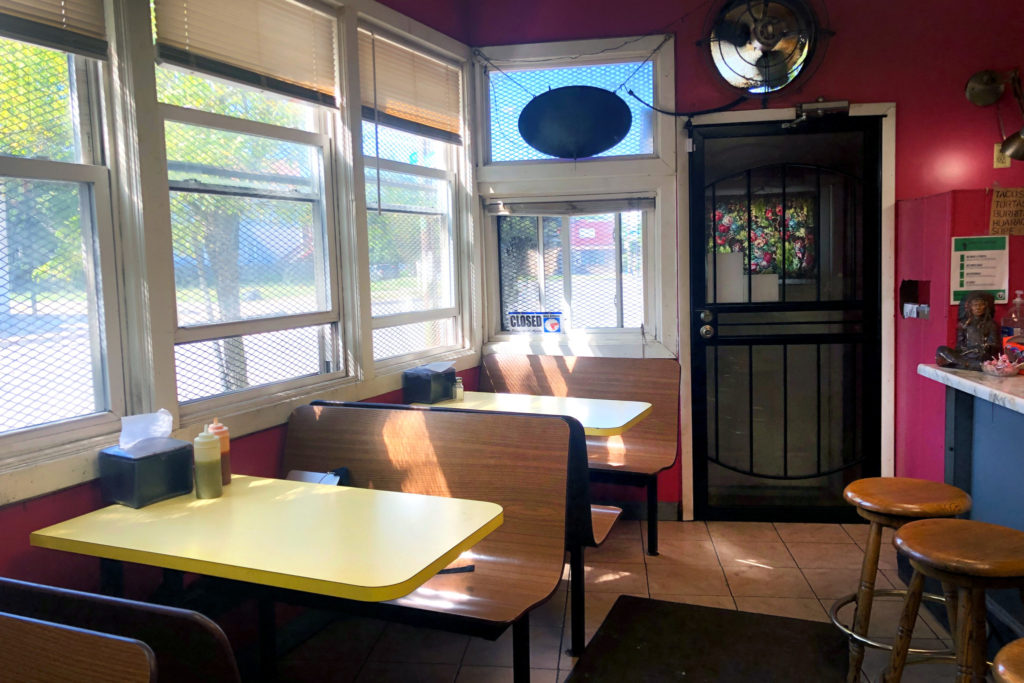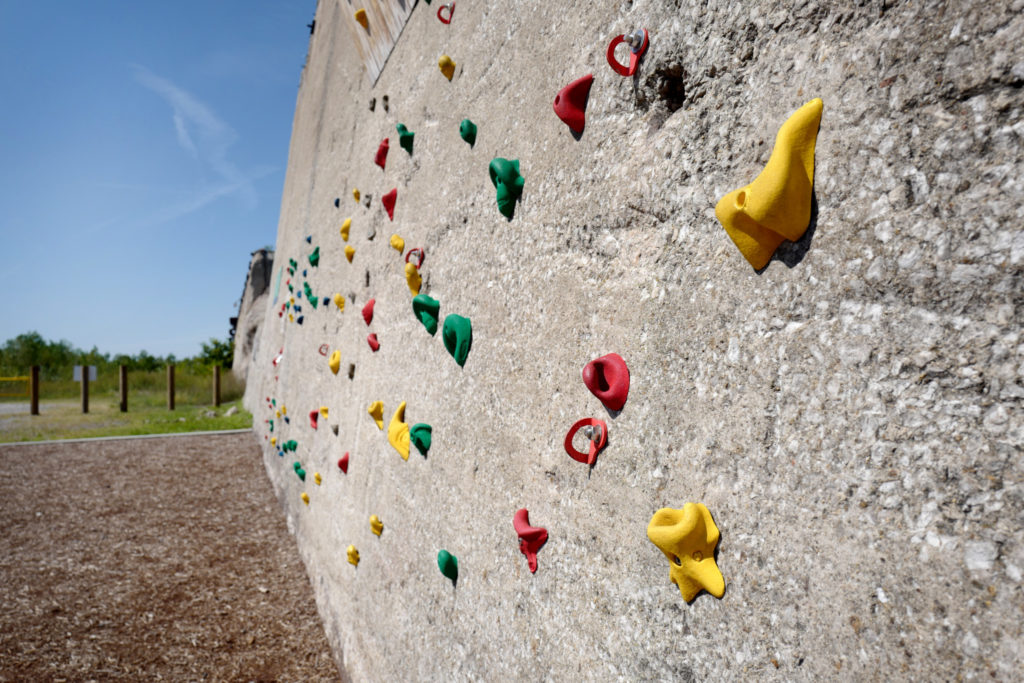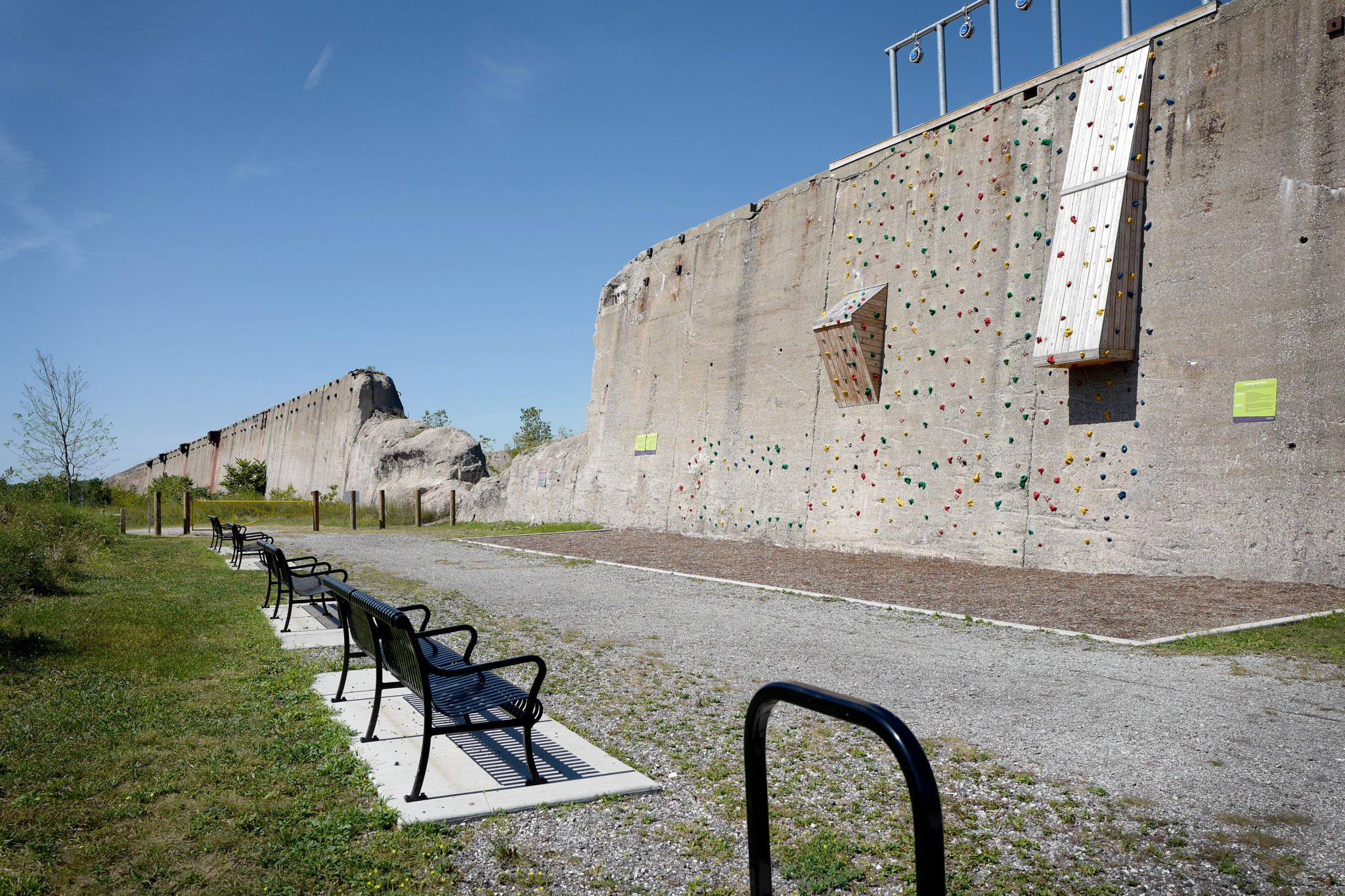- Best Point Farthest from a Public Road: The Calumet Breakwater
- Best Freshly Fried Tortilla: El Jacalito
- Best Rock-Climbing on an Abandoned Steel Plant: Rock-climbing wall in Steelworkers Park
- The Best Plantain and Any-Meat-You’d-Like Stew: Southside African Restaurant
Maryam and Ade Lala have lived in South Chicago for a decade and have owned and operated their restaurant, Southside African Restaurant, for four years. I sat with the two of them in the newly finished dining area of their restaurant to discuss their experiences in the neighborhood. Maryam did most of the talking, so the words below are hers. Interview has been edited for clarity.
On 83rd and Baltimore, you know this street right here, everybody knows each other. The houses on the streets: the owners have been living here for years. When there’s a new neighbor around we’re going to know. It’s not like I know everybody by their names, but I know the faces, and most times when we barbecue, they stop by. There’s a lot of stuff to do: we barbecue outside, mostly Fridays. We’ll be out there until like ten. Some with kids, you know. People bring their kids so they run around and play while we just talk. We’ve created a base for ourselves.
We meet [in the neighborhood] and it’s been like a family, since everyone is here like it’s their home. We look out for each other, it’s been impressive. Let me give you an example: if people are arguing, you’ll have neighbors come out and ask “Are you good, are you good?” Some of them, before we wake up and if it snows in the middle of the night, [will] shovel before we’re awake.
We moved [to South Chicago] in 2009, and [the neighborhood] is calming down. It’s been kinda hot this summer, there’s been a lot—but it’s nice. If more businesses opened around the community, it’s going to calm it down [even more]. When we started [the restaurant] our landlord wasn’t doing it for the money, you know, because he was doing okay. It’s been so nice, it’s been fair.
Sometimes when I go out and people ask me what I do, I say I own a restaurant on the South Side. They ask what restaurant and I say Southside African Restaurant. They’re like, “Ohhh, I’ve been hearing about that place, that’s the most peaceful place on the South Side.” We have American friends, we have Mexican friends. If Americans came down and saw us barbecue…I wish they could come out and see how we celebrate. It’s not like the guys don’t fight; they fight now but the next moment you see them talking again. So they may beat each other up but the next moment you seem them talking with each other. That’s how it is here, that’s just the atmosphere. You come right now, everything is peaceful. After work everyone just comes here to chill. Some are going to bring cases of beer, you know, it’s just peaceful like that.
I know there are people that look at us like we are foreigners, making money off their land. People feel like that but I want to make people understand that we are family. Where we come from, if we have an issue with someone we throw the punches, but we put the weapons on the ground. The ones that understand us, we are friends. (As told to Eli Hoenig)
Best Point Farthest from a Public Road
The Calumet Breakwater
The site of the closed-down U.S. Steel South Works plant is comprised of two regions, divided cleanly by a canal connecting the shuttered steel plant to Lake Michigan. Steelworkers Park lies south of the canal, boasting well-maintained landscaping and an array of walking trails and historical sites. The north side of the canal is fallow land; abandoned by the Chicago Park District, Park No. 566 continues to grow wild. It also holds the Calumet Breakwater, a mile-long jetty that pierces far into Lake Michigan, then turns south to cross the state line into Indiana.
On stormy days, the waves splash freely onto the jetty, making walking on the concrete barrier a perilous endeavor and, simply put, a very bad decision. When the weather is calm, however, and the breakwater is not absorbing the blows of the lake—U.S. Steel constructed the barrier to protect their factory from the throes of Lake Michigan—you can easily walk the length of the jetty, all the way to the modest light tower at the tip. Along the way, you will enjoy views of downtown, a clear view of the remaining heavy industry in the area, and a unique feeling of isolation from the city.
After walking a few hundred yards into the lake, occasionally picking your way through patches of uneven stone, you’ll have reached a very special point in the city, the significance of which was discovered by statistician and explorer Eric Potash. Separated from traffic by acres of undeveloped park land, in addition to the portion of the lake now between you and the shoreline, you’ll have reached the point in Chicago farthest from a public road.
To arrive at the Calumet Breakwater, you’ll turn left at the intersection of 85th Street and Lake Shore Drive, turning away from the center of South Chicago towards the lake. It is easy to bike along an old service road adjacent to the canal. The canal is enclosed by concrete siding on which a concerned citizen has spray-painted in large block letters SAFETY FIRST. Keep this sound advice in the front of your mind, as this part of the park is not technically open to the public and I know little of its potential dangers. After riding the length of the canal, you’ll reach the lake shore, which is covered by tall grass and shrubbery in the summer but is bare in colder months. The breakwater, lying at the entrance of the canal, is impossible to miss. (Eli Hoenig)
Calumet Breakwater, E. 85th St. & S. Lake Shore Dr.
Best Freshly Fried Tortilla
El Jacalito

El Jacalito has no identifying sign: only the faux-neon writing spelling “open” in the front window explicitly marks it as a business. I could discern the storefront’s identity easily, however, by its distinct yellow-and-blue paint job and the smell of rich handmade tacos emanating through the grated windows onto the sidewalk. This lunch-oriented taqueria, located at the northern and quiet tip of Commercial Avenue, is owned and operated solely by three members of a single family. Upon entering the restaurant, which is dominated by kitchen space and holds no more than five booths, I was immediately greeted with genuine enthusiasm by Linda, the owner and taco chef. I ordered at the counter, glancing at the menu written in Spanish posted on the wall, but mostly going by Linda’s recommendation. I should get the Super Taco, of course, she emphasized with equal enthusiasm as her initial greeting. This dish is easily the most popular in El Jacalito, and for good reason.
I considered briefly trying the gordita or satisfying my vegetarian inclinations with the veggie taco. After all, Janette, Linda’s daughter and perhaps the one who interfaces with customers most easily and frequently, assured me that their vegetarian options are excellent and include an assortment of vegetables, rice, beans, and cheese. Eventually, however, I followed Linda’s recommendation, then promptly and happily consumed their steak-stuffed specialty. With more marinated meat than I had eaten in the past year, the Super Taco was as filling as Linda advertised—very—but the best part of the experience was easily the tortilla, large and robust enough to hold a mountain of peppers and steak without breaking. Yet so much more than a vessel, El Jacalito’s tortillas are thick, chewy, and full of flavor, most likely enhanced by the juices soaked up from the skillet Linda cooked it on just minutes earlier. After tasting the true El Jacalito tortilla, I’m not sure I will ever happily eat the grocery store version again. (Eli Hoenig)
El Jacalito, 8465 S. Commercial Ave. Monday–Friday, 9:30am–5:30pm; Saturday, 9:30am–4:30pm; closed Sunday. (773) 933-6840.
Best Rock-climbing on an Abandoned Steel Plant
Rock-climbing wall in Steelworkers Park

The final remnants of the U.S. Steel South Works plant, two pairs of thirty-foot-tall concrete barriers, run for a half a mile from the coast of Lake Michigan along Steelworkers Park. When the factory was operational, these ore walls stored unprocessed iron and limestone; now they enclose dense wildlife (according to the Tribune, more than two hundred native bird species) untouched by human traffic. In 2018, however, the Chicago Parks District installed rock-climbing features on the outer face of the ore wall abutting the park, allowing humans to officially, in an entirely new manner, utilize the walls once more. (Read more about their history in the Far Southeast Side section of this issue.)
The climbing features are comprised of a dense array of artificial holds—like those found in an indoor climbing gym—along with two wooden structures that create forty-five and ninety-degree overhangs. The experienced rock-climber will need to get creative to challenge themselves, as the official routes only reach a 5.7 difficulty rating, according to REI’s online journal—there is, for example, a naturally formed crack running to the top of the wall that is more difficult than the established routes.
For a creative climber, or someone new to the sport, the ore walls will easily provide a morning’s worth of entertainment. I was the only climber present on a summer Saturday afternoon, so the chances of being the sole climber appear high. The Parks District installed a set of auto-belays, but they are padlocked and only open for official climbing days, which based on the very limited information publicly available have so far only occurred during the summer months (ending Labor Day). Still, the facility has plenty of structures for top-roping; for the more experienced it has built-in bolts for lead-climbing; and with a soft wood-chip patch below the wall, the ore wall is also highly suitable for bouldering.
After tiring myself out on the wall, I was able to walk around Steelworkers Park—worthy of a visit on its own. Directly on the lakefront, the park is well maintained with gently curving gravel paths, shaded grassy spots for picnics or catnaps, and a bronze statue of a steelworker’s family created by the local artist Roman Villarreal. I was also able to climb up a decaying part of the ore wall, the top of which provides an expansive view of the lake and the steeple of St. Michael the Archangel, a towering Catholic church in South Shore. I was also able to gaze down on the dense wildlife between the ore walls, uncaring and unaffected by the developments on its southern front. (Eli Hoenig)
Ore walls at Steelworkers Park, E. 87th St. & S. Lake Shore Dr. 6am–11pm, daily. (312) 720-0940. chicagoparkdistrict.com/parks-facilities/steelworkers-park
The Best Plantain and Any-Meat-You’d-Like Stew
Southside African Restaurant
The boundaries of Southside African Restaurant are defined less by any formal seating area, but instead by where customers, employees, and friends decide to stay and make conversation. Arriving at this Nigerian restaurant, you’ll inevitably find a cluster of people hanging about in the parking lot or on the sidewalk, chatting over their food or just enjoying each other’s company. As a result, Southside African serves as more than just a restaurant; it is a gathering place for many in the neighborhood, a self-defined peaceful place that also serves amazing food.
Southside African inhabits a previously unoccupied building on the very north side of South Chicago. According to Lala, who owns the restaurant with his partner Maryam, up until the nineties it held Pepe’s Mexican Restaurant, traces of which are still present in the current setup. A plexiglass window, for example, separates the customer from the kitchen and the server taking orders. Many patrons order food to go, but the ones who stay sit in a long and narrow room reminiscent of a train car, with two columns of small booth-like tables set up parallel to each other on either wall. Lala and Maryam just this week finished preparing additional seating that will be a more conventional and spacious dining area. They hope the additional room will be not only a place to eat, but also a space for parties and events.
When ordering, it is easy to be overwhelmed by the culinary options: much of the menu presumes some familiarity with Nigerian cooking, and, as I learned, many options aren’t explicitly written down. I turned to Maryam, who was working the counter at the time, for recommendations. A friendly customer walking through the restaurant added his opinion, then so did the next person in line for food, turning the ordering process into a lesson on the varieties of Nigerian dinner options.
As Lala emphasizes, their cooking is authentic Nigerian cuisine, the same food he’s been eating his entire life; they do not compromise for an American customer base. The jollof rice is infused with a smoky and spicy flavor, relying on a rich palm oil coating to give it a burnt orange color. Although the kitchen has a heavy emphasis on meat, typical of Nigerian cooking, the cooks happily accommodate vegetarians, for whom options include okra soup, jollof rice, and, if you call ahead, a specially prepared efo riro (vegetable stew). Their meat selection is, however, quite spectacular. Extending beyond their minimalist menu, they serve dishes ranging from beef, chicken, and tilapia to goat, cow skin, and turkey gizzard. For those looking for a simple rice dish, or the more adventurous who care to try something like the plantain and chicken gizzard stew, Southside African will stretch your palate while simultaneously providing a taste of South Chicago hospitality. (Eli Hoenig)
Southside African Restaurant, 8311 S. Baltimore Ave. Monday–Friday, 10am–10pm; Saturday, 11am–10pm; closed Sunday. (872) 666-5588.



I don’t understand. It looks like access to the break water is all “no trespassing” area?